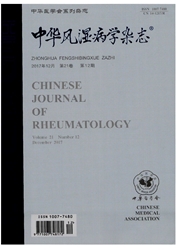

 中文摘要:
中文摘要:
目的探讨Th17细胞在静脉注射丙种球蛋白(IVIG)无反应型川崎病(KD)免疫发病机制中的作用。方法选取KD患儿45例,其中IVIG敏感型KD35例,IVIG无反应型KD10例,同年龄健康对照组30名。KD患儿分别于IVIG治疗前后直接取血备检,IVIG无反应型KD分别在病程第8、9、11天取血备检。采用实时荧光定量聚合酶链反应(PCR)检测CD4^+T细胞白细胞介素(IL)-17A/F、转录因子ROR-γt mRNA表达;采用流式细胞术检测外周血Th17细胞占CD4^+T细胞比例。应用酶联免疫吸附试验(ELISA)检测Th17细胞相关的细胞因子IL-17A和IL-6的表达。结果①急性期KD患儿CD4^+T细胞IL-17A/F表达明显高于对照组(P〈0.01);②急性期IVIG无反应型KD患儿CD4^+T细胞内IL—17蛋白、IL-17A/F mRNA、Th17细胞转录因子ROR—M的基因表达明显高于IVIG敏感型KD,经IVIG治疗后敏感型KDTh17细胞相关因子表达明显降低(P〈0.01),无反应型KD Th17细胞相关因子仍持续高表达(P〉0.05);③急性期KD患儿治疗前IL-17A和IL-6血浓度明显高于对照组(P〈0.01),其中IVIG无反应型KD活化细胞因子水平明显高于IVIG敏感型KD组(P〈0.01)。经治疗后均有下降趋势,但IVIG无反应型KD仍高于敏感型KD(P〈0.01);④甲泼尼龙冲击治疗IVIG无反应型KD当天退热,血浆IL-6,IL-17A较前明显降低,C反应蛋白(CRP)恢复快,能够迅速控制血管炎性反应。结论Th17细胞过度活化可能是导致IVIG无反应型KD的原因之一。
 英文摘要:
英文摘要:
Objective To investigate the alteration and significance of T help 17 cells (Th17), in patients with intravenous immune globulin-resistant Kawasaki disease (KD). Methods Forty-five children with KD (thirty-five as sensitive group and ten as the resistant group) and thirty age-matched healthy children were studied. Real-time PCR was used to evaluate the mRNA levels of IL-17A/F, ROR-γt. The proportion of Th17 in peripheral blood was detected by flow cytometric analysis. Th17-related plasma cytokine (including IL-17A and IL-6) concentrations were measured by enzyme-linked immunosorbent assay (ELISA). Results (1) Compared with healthy controls, transcription levels of IL-17A/F were significantly up- regulated during acute phase of KD (P〈0.01). (2) Compared with sensitive group, the transcription levels of IL-17A/F, ROR-γt were significantly up-regulated during acute phase in immune globulin-resistant KD (P〈 0.01 ), and down-regulated after treatment with intravenous immunoglobulin (IVIG) therapy in sensitive group (P〈0.01), but there was no significant difference in the levels of expression in resistant group (P〉0.05). There was significant difference in serum IL-17A,IL-6 before or after IVIG between resistant and nonre- sistant group (P〈0.01). (3) Compared with the normal controls, serum IL-17A, IL-6 were markedly elevated in patients with KD. There was significant difference in serum IL-17A and IL-6 concentrations between resistant and sensitive group before IVIG treatment (P〈0.01). The resistant group showed significantly high IL-17A, IL-6 after IVIG. There was no significant difference in the severity of decrease before and after IVIG in both groups, but it was found that serum IL-17A and IL-6 had a tendency to decrease after treatment with IVIG. (4) Methylprednisolone might down-regulate inflammatory response through inhibiting the secretion of inflammatory IL-6 and IL-17A cytokines in acute stage of immunoglobulin-resistant KD. Treatm
 同期刊论文项目
同期刊论文项目
 同项目期刊论文
同项目期刊论文
 期刊信息
期刊信息
